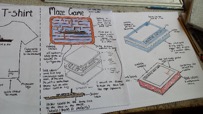Shop ’til You Drop has seen us working with Year 10 GSCE Graphic Products students. The students were presented with a live brief, which asks them to research and produce a product which can be sold in the Museum’s shop, using Windermere Jetty as their client. Following an introduction to the Museum, students were able to talk through the brief for the project, including:
- the target audience, children aged 6-9 years old
- where the product will be sold, in the Windermere Jetty shop
- product price, pocket money priced items
- the materials required to make the product
Following an introduction and time to do some initial research, the students came to Windermere Jetty for a site visit.
Each student has researched what other museums sell in their shops, generated ideas of what they would like to develop and have chosen two products to focus their attention on. You can see examples of the group’s work below.
The project is now coming to a close as we approach the Christmas holidays. The group has shown a high level engagement with the project and the school is planning on running the project as part of the next course starting in September 2017.

















